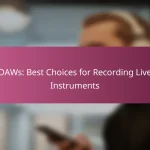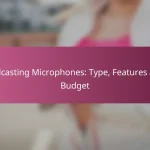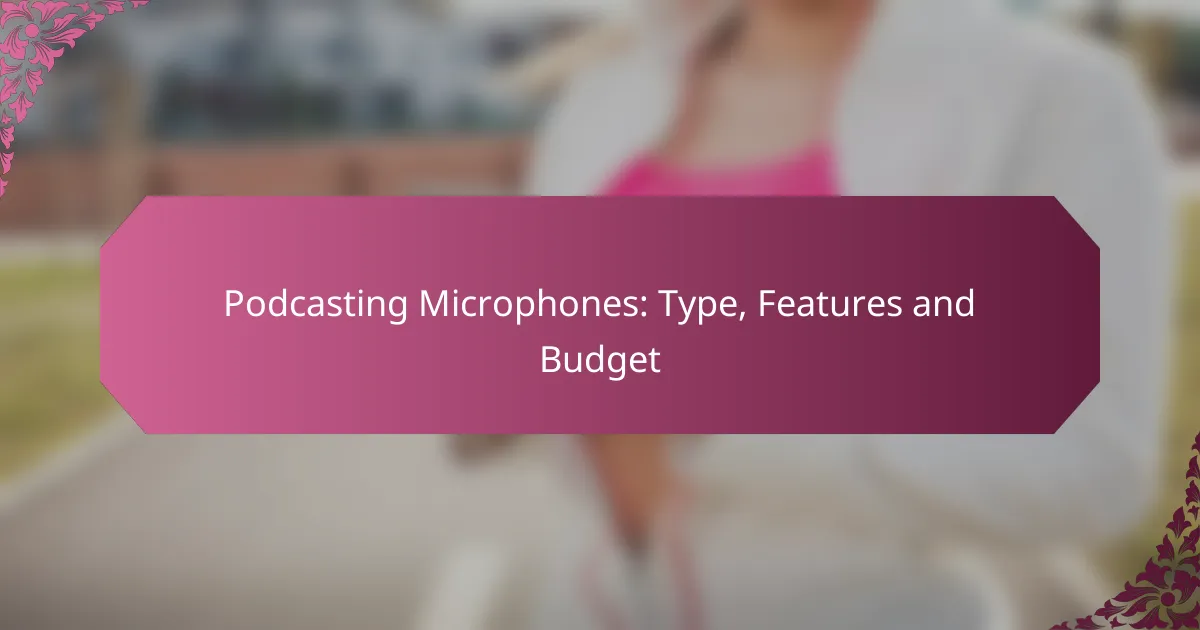Choosing the right podcasting microphone is essential for achieving high-quality audio while staying within your budget. For beginners, options like the Audio-Technica AT2020 and Blue Yeti USB Microphone offer a balance of affordability and performance. When selecting a microphone, consider key features such as polar patterns and connectivity to enhance your recording experience.

Which podcasting microphones are best for beginners in the US?
For beginners in the US, the best podcasting microphones combine affordability, ease of use, and solid audio quality. Options like the Audio-Technica AT2020, Blue Yeti USB Microphone, and Samson Q2U are popular choices that cater to various needs and budgets.
Audio-Technica AT2020
The Audio-Technica AT2020 is a versatile condenser microphone known for its clear sound and durability. It features a cardioid pickup pattern, which helps isolate your voice while reducing background noise, making it ideal for home studios.
When using the AT2020, consider pairing it with an audio interface for optimal performance. This microphone typically ranges from $80 to $100, making it a solid investment for beginners looking to elevate their podcasting quality.
Blue Yeti USB Microphone
The Blue Yeti USB Microphone is a favorite among podcasters due to its user-friendly design and multiple recording patterns. It offers cardioid, omnidirectional, and bidirectional modes, allowing you to adapt to different recording environments.
Its plug-and-play functionality means you can connect it directly to your computer without additional equipment. Priced around $120 to $150, the Blue Yeti provides great value for those who want flexibility and ease of use in their podcasting setup.
Samson Q2U
The Samson Q2U is a dynamic microphone that offers both USB and XLR outputs, making it a great choice for beginners who may want to expand their setup later. Its cardioid pattern effectively captures vocals while minimizing unwanted noise from the sides and rear.
With a price point of about $60 to $80, the Q2U is budget-friendly and comes with essential accessories like a desktop stand and USB cable, making it a practical option for new podcasters.
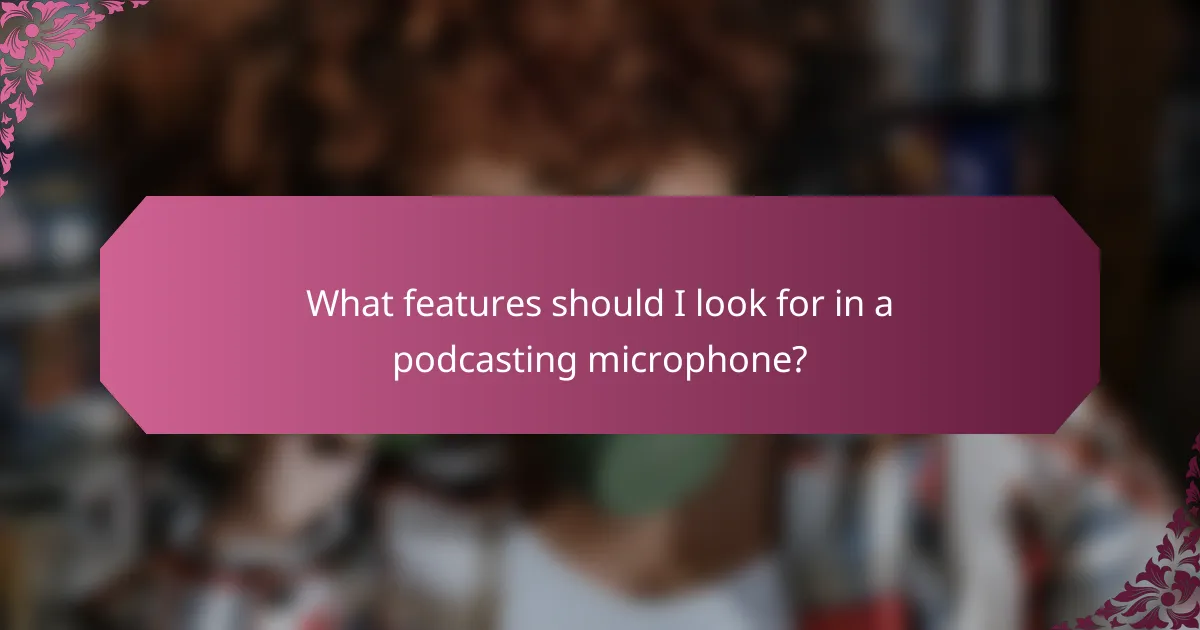
What features should I look for in a podcasting microphone?
When selecting a podcasting microphone, focus on features that enhance sound quality and usability. Key aspects include polar patterns, frequency response, and connectivity options, which all play a significant role in capturing clear audio for your recordings.
Polar patterns
Polar patterns determine how a microphone picks up sound from different directions. The most common types for podcasting are cardioid, omnidirectional, and bidirectional. Cardioid microphones capture sound primarily from the front, making them ideal for solo podcasters or interviews, while omnidirectional mics pick up sound from all directions, suitable for group discussions.
Consider your recording environment when choosing a polar pattern. If you’re in a noisy space, a cardioid pattern can help isolate your voice from background noise. Conversely, if you’re recording multiple speakers, an omnidirectional mic may be more effective.
Frequency response
Frequency response refers to the range of sound frequencies a microphone can capture, typically measured in Hertz (Hz). For podcasting, a frequency response that covers the human voice range, approximately 80 Hz to 15 kHz, is essential. This ensures clarity and richness in vocal recordings.
Look for microphones with a flat frequency response for natural sound or those with slight boosts in the mid-range for enhanced vocal presence. Avoid mics that have significant dips or peaks in their response, as this can lead to unnatural sound reproduction.
Connectivity options
Connectivity options are crucial for integrating your microphone with recording equipment. Common types include USB and XLR connections. USB microphones are user-friendly and plug directly into computers, making them great for beginners. XLR microphones, however, require an audio interface or mixer but offer superior sound quality and flexibility.
Consider your recording setup and future needs. If you plan to expand your podcasting gear, investing in an XLR microphone may be worthwhile. Ensure that your chosen microphone is compatible with your recording devices to avoid connectivity issues.
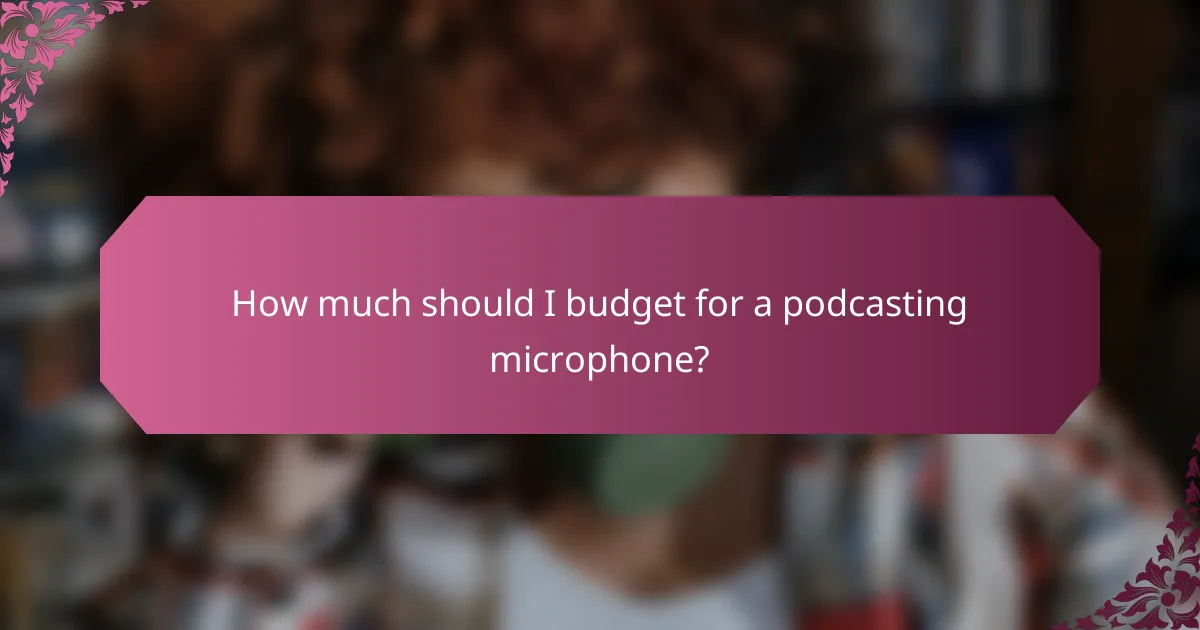
How much should I budget for a podcasting microphone?
Budgeting for a podcasting microphone typically ranges from under $100 for entry-level models to over $300 for professional-grade options. Your budget will influence the quality, features, and durability of the microphone you choose, so consider your specific needs and goals.
Entry-level options under $100
Entry-level microphones are ideal for beginners or those on a tight budget. These models often include USB microphones that are easy to set up and use, making them perfect for home recording or casual podcasting.
Popular choices in this category include the Audio-Technica ATR2100x-USB and the Samson Q2U, both of which offer decent sound quality without breaking the bank. Expect to spend between $50 and $100 for these options.
Mid-range options $100-$300
Mid-range microphones provide enhanced sound quality and additional features, making them suitable for more serious podcasters. These often include XLR connections, allowing for greater flexibility and compatibility with professional audio equipment.
Examples include the Rode NT-USB and the Shure MV7, which offer superior audio fidelity and build quality. Prices typically range from $100 to $300, providing a good balance between performance and cost.
Professional options over $300
Professional microphones are designed for high-quality recordings and are often used in studios. These models typically feature advanced technology, superior materials, and exceptional sound reproduction.
Microphones like the Shure SM7B and the Neumann TLM 102 fall into this category, with prices starting around $400 and going significantly higher. Investing in a professional microphone can elevate your podcast’s audio quality, making it more appealing to listeners.
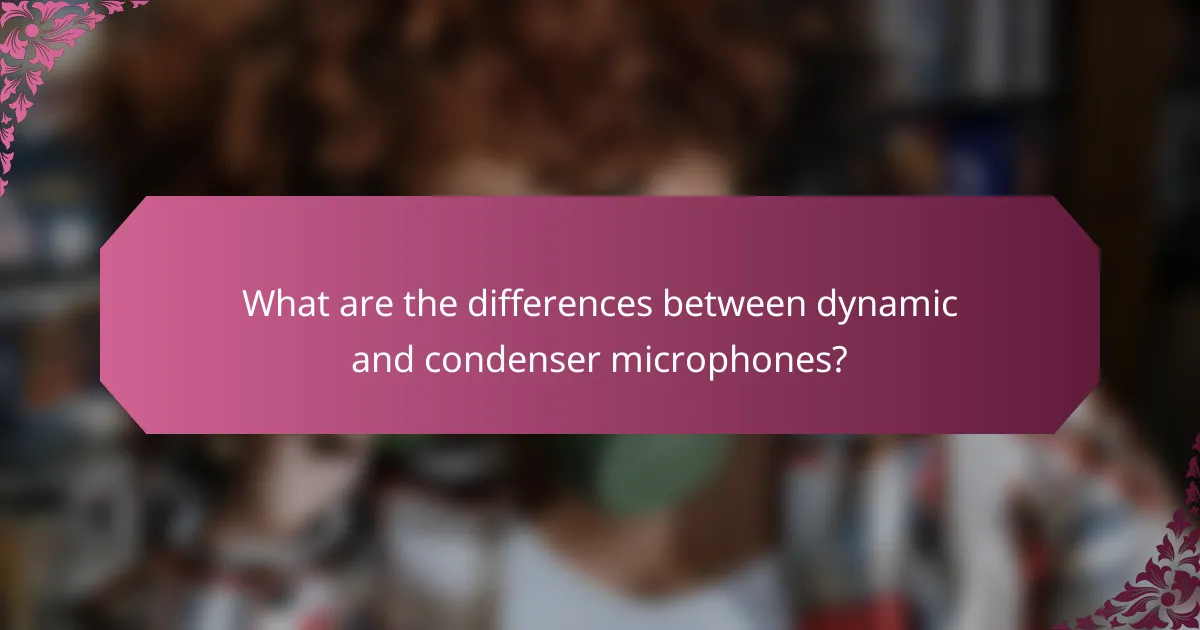
What are the differences between dynamic and condenser microphones?
Dynamic microphones are robust and ideal for live performances, while condenser microphones are more sensitive and suited for studio recording. The choice between them depends on the recording environment and the desired sound quality.
Dynamic microphones for live settings
Dynamic microphones are designed to handle high sound pressure levels, making them perfect for live settings. They are less sensitive to background noise and can effectively capture vocals and instruments in loud environments.
When selecting a dynamic microphone, consider factors such as durability and feedback rejection. Popular models like the Shure SM58 are known for their reliability and performance in live situations.
Condenser microphones for studio recording
Condenser microphones excel in studio recording due to their sensitivity and wide frequency response. They capture subtle nuances in sound, making them ideal for vocals, acoustic instruments, and detailed soundscapes.
When choosing a condenser microphone, look for features like a low-cut filter and pad switch to manage high sound levels. Models such as the Audio-Technica AT2020 are favored for their clarity and versatility in studio applications.
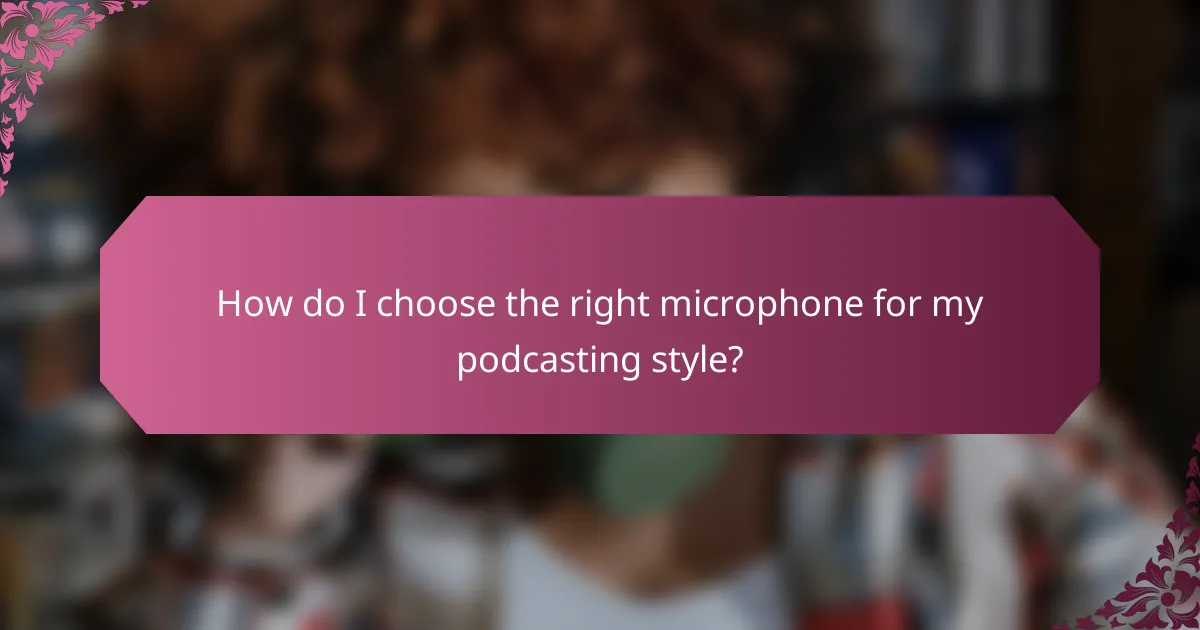
How do I choose the right microphone for my podcasting style?
Choosing the right microphone for your podcasting style involves understanding your recording environment, the type of content you produce, and your budget. Consider factors such as microphone type, features, and how they align with your specific podcasting needs.
Interview style considerations
For interview-style podcasts, a dynamic microphone is often preferred due to its ability to minimize background noise and focus on the speaker’s voice. Look for microphones with a cardioid pickup pattern, which captures sound primarily from the front, reducing interference from side and rear sounds.
Additionally, consider using multiple microphones to ensure each participant has a clear and balanced sound. USB microphones can be convenient for remote interviews, while XLR microphones offer better sound quality and flexibility for in-person setups.
Solo podcasting needs
When podcasting solo, condenser microphones are typically favored for their sensitivity and clarity, making them ideal for voice recording. A large diaphragm condenser microphone can capture a rich sound, enhancing vocal warmth and detail.
It’s also beneficial to invest in a pop filter to reduce plosive sounds and a shock mount to minimize vibrations. If you’re on a budget, USB condenser microphones can provide excellent quality without the need for additional equipment.
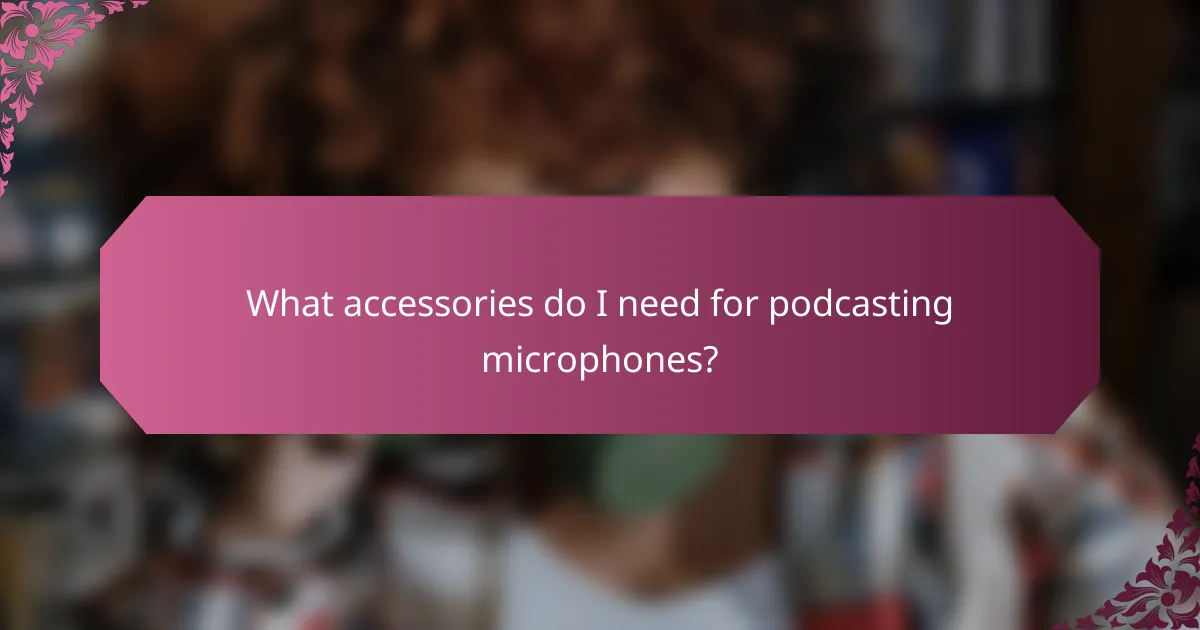
What accessories do I need for podcasting microphones?
To enhance the quality of your podcasting microphones, consider essential accessories like pop filters, shock mounts, and microphone stands. These tools help improve sound clarity, reduce unwanted noise, and provide stability during recording sessions.
Pop filters
Pop filters are designed to eliminate plosive sounds, such as “p” and “b” sounds, that can cause distortion in recordings. They are typically made of a thin mesh material stretched over a circular frame and placed in front of the microphone. Investing in a good pop filter can significantly enhance audio quality, making your podcast sound more professional.
When choosing a pop filter, look for one that is easy to attach and adjust. Most pop filters are compatible with various microphone types and sizes, so ensure it fits your setup. Prices generally range from $10 to $50, depending on the brand and features.
Shock mounts
Shock mounts are crucial for isolating your microphone from vibrations and handling noise that can occur during recording. They suspend the microphone in a cradle, minimizing unwanted sounds caused by movement or contact with surfaces. This is particularly important in environments where external noise is a factor.
When selecting a shock mount, ensure it is compatible with your microphone model. Many shock mounts come with adjustable features for optimal positioning. Prices can vary widely, from around $20 to over $100, based on quality and design.
Microphone stands
Microphone stands provide stability and positioning flexibility for your podcasting setup. They come in various styles, including desktop, floor, and boom stands, allowing you to choose one that best fits your recording space. A sturdy stand helps prevent unwanted movement and ensures consistent audio capture.
Consider the height and adjustability of the stand, especially if multiple speakers will use it. Basic microphone stands typically start around $15, while more advanced models with additional features can cost upwards of $100. Ensure the stand can support the weight of your microphone for optimal performance.

